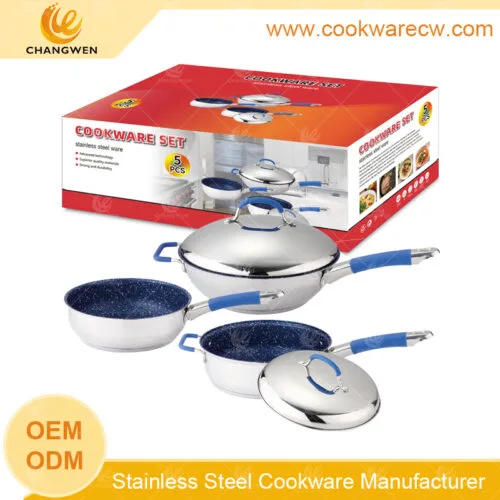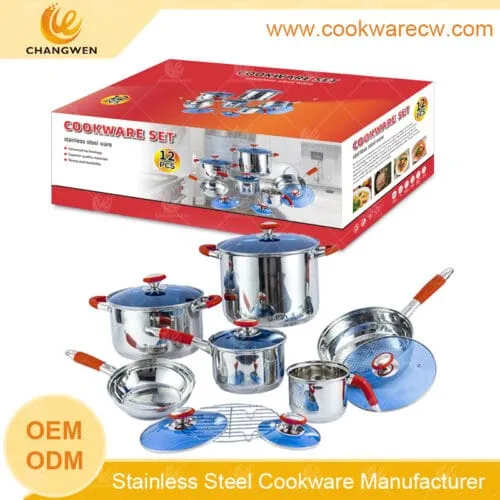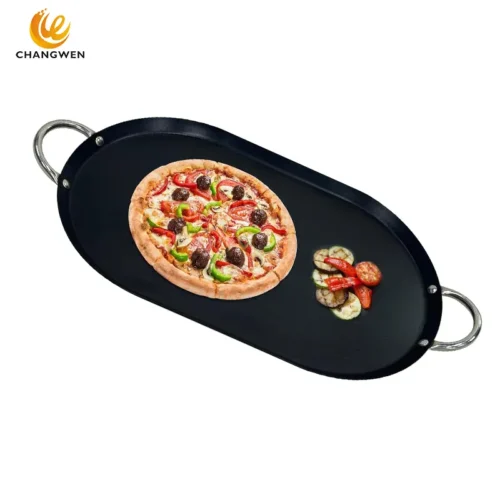Blog
Changwen is a leading cooking utensils manufacturers. We supply high quality stainless steel cooking pots and pans to all over the world. We can also customize the local hot-selling stainless steel pots and pans. Please send your requirements to Changwen.
A Deep Dive into Stainless Steel Cookware: Comparing 304, 316, 430 and Three-layer Stainless Steel Pots
Stainless steel pots are favored for their durability, maintenance ease, and shiny aesthetic. But not all stainless steel is created equal. The primary difference between various types of stainless steel lies in their composition, intrinsic properties that directly affect their performance. Today, let’s focus on three popular grades: 304 (18/8), 316 (18/10), 430 and Three-layer stainless steel pots.
304 Stainless Steel Pots (18/8 grade)
Advantages:
Corrosion-Resistant: Designed with a high percentage of chromium and nickel, 304 stainless steel pots resist rust, corrosion, and oxidation.
Food Safe: The 304 grade is non-toxic and doesn’t leach dangerous materials into food.
Heat Resilient: 304 stainless steel pots withstand high cooking temperatures.
Disadvantages:
Uneven Heating: These pots do not conduct heat evenly and often require a copper or aluminum core for improved cooking performance.
Pricing: High-quality 304 stainless steel pots tend to be more expensive than their lower-grade counterparts.
316 Stainless Steel Pots (18/10 grade)
Advantages:
Greater Corrosion Resistance: The addition of molybdenum makes 316 grade stainless steel even more resistant to corrosion than 304[2%5E].
Durable: This grade is known for its increased strength and durability.
Disadvantages:
Price: The higher quality materials in 316 stainless steel pots often come with a hefty price tag.
Heat Distribution: As with the 304 grade, 316 stainless steel pots require an additional heat-conductive layer for better cooking results.
430 Stainless Steel Pots
Advantages:
Affordability:430-grade steel pots are typically more affordable than 304 and 316 stainless steel pots.
Magnetic: These pots are magnetic, making them compatible with induction stovetops.
Disadvantages:
Lower Corrosion Resistance: 430 stainless steel has less chromium and no nickel compared to 304 and 316, reducing its corrosion resistance.
Durability Issues: This type of stainless steel pot is prone to pitting and corrosion, potentially decreasing its lifespan.
Three-layer Stainless Steel Pots
The three-layer steel is made of multi-layer composite steel. The outer layer is 430 magnetic steel, the middle layer is aluminum, and the inner layer is 304 stainless steel for food contact.
Advantages:
1. Good heat uniformity: Due to the excellent thermal conductivity of the aluminum in the middle layer, the three-layer steel pot can be heated quickly and evenly, thus better ensuring the quality and taste of the food.
2. Good wear resistance: The surface of the three-layer steel pot is composed of two layers of stainless steel, so it has good wear resistance and has a long service life.
3. Easy to clean: The surface of the three-layer steel pot is smooth and will not absorb dirt and bacteria, so it is easy to clean and maintain.
4. Safety and hygiene: The three-layer steel pot is composed of stainless steel, aluminum and other materials. It will not release harmful substances and will not affect the taste and nutrition of the food, so it is a safe and hygienic pot.
Disadvantages:
1. Higher price: Due to the use of a variety of materials, the price of three-layer steel pots is higher than other stainless steel pots.
2. Heavy weight: Due to the use of a variety of materials, the three-layer steel pot is heavy and may be inconvenient to use.
304 and 316-grade stainless steel pots are widely preferred by professional chefs and home cooks alike. Compared to these, 430-grade stainless steel pots are an affordable option but might not offer the same corrosion resistance or durability. The key is finding the right balance that fits your budget and cooking needs.
The three-layer stainless steel pot is made of stainless steel with additional layers to heat the pot evenly, conduct heat quickly, and is magnetically conductive, making it suitable for induction cookers.
Popular Blog
The difference between 304 stainless steel and 316 stainless steel
How to deal with blackening of stainless steel pots
Are stainless steel pots really rust-free?
Best Stainless Steel Nonstick Cookware
Is it difficult to clean the stainless steel pot after it is charred?
How to pre-seasoned stainless steel pot
How do I find the manufacturer of cookware
Which parts of cookware can be customized?
How to maintain stainless steel tableware
Tags
Recommend Products

hot sales cookware supplier 12pcs cooking pots and pans stainless steel cookware set fry pan saucepan coating tea kettle CW-M1223

hot sales 12pcs stainless steel cookware set saucepan casserole non-stick frypan with golden handles & knobs & 5-stepped capsule bottom CW-M1202

color coating surface stainless steel pots non-stick frypan golden S/S handles and knobs 430 protector for induction CW-M1225

Stainless Steel Cook Pot Set CW-M0606

Customize color box 3pcs fry pan set blue marble nonstick coating frying pans stainless steel lids and blue silicone cover CW-M0501G

Hotsale 12pcs stainless steel cooking set popular pots and pans kitchen soup stock pot with red silicone steamer rack China factory customized color box CW-M1306G-03

New design stainless steel 12pcs pots wholesale wire handle and knob cookware mirror polished saucepan casserole kitchen pots nonstick coated frypan CW-M1218

Stainless Steel Griddle For BBQ Grills








